DOI:10.32604/cmc.2022.018819

| Computers, Materials & Continua DOI:10.32604/cmc.2022.018819 |  |
| Article |
Automatic Classification of Superimposed Modulations for 5G MIMO Two-Way Cognitive Relay Networks
Jouf University, College of Computer and Information Sciences, Computer Engineering and Networks Department, Sakaka, 72388, Kingdom of Saudi Arabia
*Corresponding Author: Ahmad Almadhor. Email: aaalmadhor@ju.edu.sa
Received: 22 March 2021; Accepted: 09 June 2021
Abstract: To promote reliable and secure communications in the cognitive radio network, the automatic modulation classification algorithms have been mainly proposed to estimate a single modulation. In this paper, we address the classification of superimposed modulations dedicated to 5G multiple-input multiple-output (MIMO) two-way cognitive relay network in realistic channels modeled with Nakagami-
Keywords: Automatic classification; MIMO two-way cognitive relay network; Nakagami-m channels; superimposed modulations; 5G
Recently, a lot of attention has been paid to the two-way relaying (TWR) scheme, which consists of the exchange information between two users via a commonly shared relay in the absence of a direct link between them [1–6]. The transmission process under a TWR channel (TWRC) is performed in two-time slots. In the first time slot, the two user nodes send signals to the relay node. In the second time slot, the relay node broadcasts the received signals to the users. In this context, the physical-layer network coding (PNC) introduced in [7], is proposed to allow the relay node to decode a linear function of the received signals, and thereafter to allow each user to decode the incoming message from the other user based on the self-message. The PNC can double the throughput of a TWRC compared to the conventional one-way relay channel by decreasing the time slots for the exchange of one packet from four to two [7,8]. It can acheive
In this paper, we propose an algorithm dedicated to the classification of the superimposed users modulations for MIMO TWCR network under Nakagami-
The rest of this paper is organized as follows: In Section 2, we model the considered MIMO TWCR network. In Section 3, we describe the proposed modulation classification algorithm. Our main results are illustrated in Section 4. Section 5 gives the conclusion of the paper.
Mathematical Notations:
2 Considered MIMO TWCR Network
A MIMO TWCR network is considered as shown in Fig. 1, where two users denoted as

Figure 1: MIMO TWRC network
For simplicity, an equal

For example, in Fig. 2, we show the constellation of the superposition of a 4PSK and a 16QAM that contains 64 different points.

Figure 2: Constellations: 4PSK signal, 16QAM signal, and superimposed 4PSK and 16QAM signal
At
where
where
In the second time slot, a linear processing is performed on the received signal at the relay node
Here, we suppose that the relay node
In this work, we consider the distances between nodes. Given the fact that
where
where
The quotient
In the second time slot,
In this context, we propose an algorithm for classifying superimposed modulations. It is mainly composed of two subsystems. The first subsystem allows to extract the higher-order statistics (HOSs) features from the equalized signal
In the following, we describe the proposed modulation classification algorithm.
3 Proposed Superimposed Modulations Classification Algorithm
The proposed superimposed modulations classification algorithm is divided into two main steps. The first one consists of extracting a set of appropriate features, while the second one concerns the classification based on supervised machine learning techniques. In the following, we explain these two steps.
3.1 Extraction of Discriminating Features
The higher-order statistics (HOSs) composed by the higher-order moments (HOMs) and the higher-order cumulants (HOCs) have shown in several recent existing works in literature their ability to classify modulations for MIMO systems [39]. In fact, each modulation scheme can be characterized by a set of HOMs and HOCs. The use of HOSs up to order eight allow the correct classification of various modulation types [40].
The
An estimation of the HOMs can be expressed as
The
The
where
The process of classification of modulations pair for the received signal
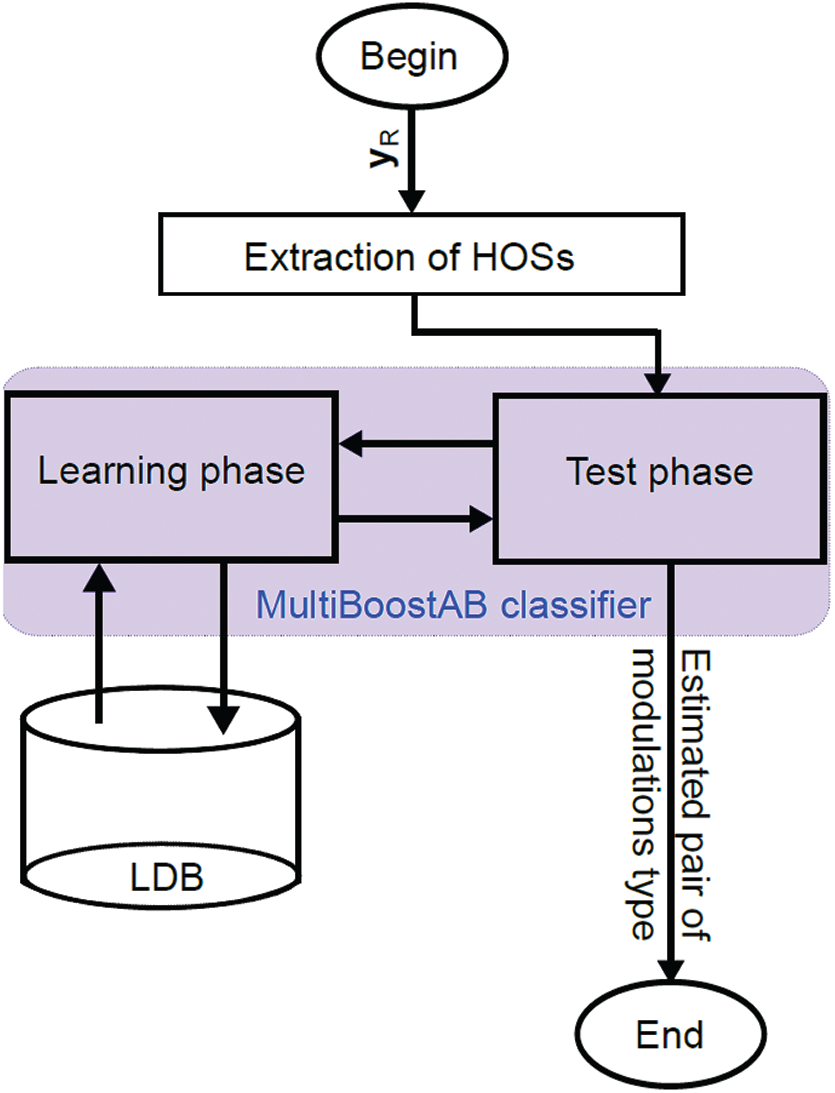
Figure 3: Process of classification of modulations pair for the received signal
In this work, we use the MultiBoosting (MultiBoostAB) classifier, which is a combination of the Boosting and the Wagging techniques [43]. We present in the Algorithm 1 the pseudocode of MultiBoostAB classifier.
The idea is to harness the benefits provided by both techniques. In fact, this classifier takes advantage of Wagging’s superior variance reduction in addition to the AdaBoost’s high bias and variance reduction. Here, we employ the C4.5 (J48) [44] as a base learning algorithm since with this latter MultiBoost classifier provides a good prediction comparing to the AdaBoost classifier. To prove the effectiveness of MultiBoostAB operating with J48 classifier in superimposed modulation classification, we carry out a comparative study with the J48 classifier alone that outperforms the performance of multilayer perceptron classifier trained with resilient backpropagation training algorithm [45].

3.3 Metrics Used for Performance Evaluation of Classifiers
In this study, we compare between classifiers using true positive (TP) rate, false positive (FP) rate, precision, recall and F-Measure metrics. The precision, recall and F-measure are given respectively as
Simulation experiments are conducted to demonstrate the advantages of the proposed automatic classification modulation algorithm. Here, we apply our proposal to classify ten combinations of modulation pairs, i.e.,
For each pair in
In this work, the probability of the correct classification is computed by
where
4.1 Accuracy of the MultiBoostAB Classifier
We firstly evaluate the performance of the MultiBoostAB classifier using a 10-fold cross-validation [47] on the training set described above. Tab. 2 displays the detailed accuracy by superimposed modulations. By analyzing the average of the TP rate, FP rate, precision, recall, F-Measure and receiver operating characteristic (ROC) area, it is clearly shown that the MultiBoostAB offers a good classification performance. In fact, the values of TP rate, precision, recall, F-Measure and ROC area are very close to
4.2 Impact of the Nakagami-
Fig. 4 shows the impact of the channel fading severity on the

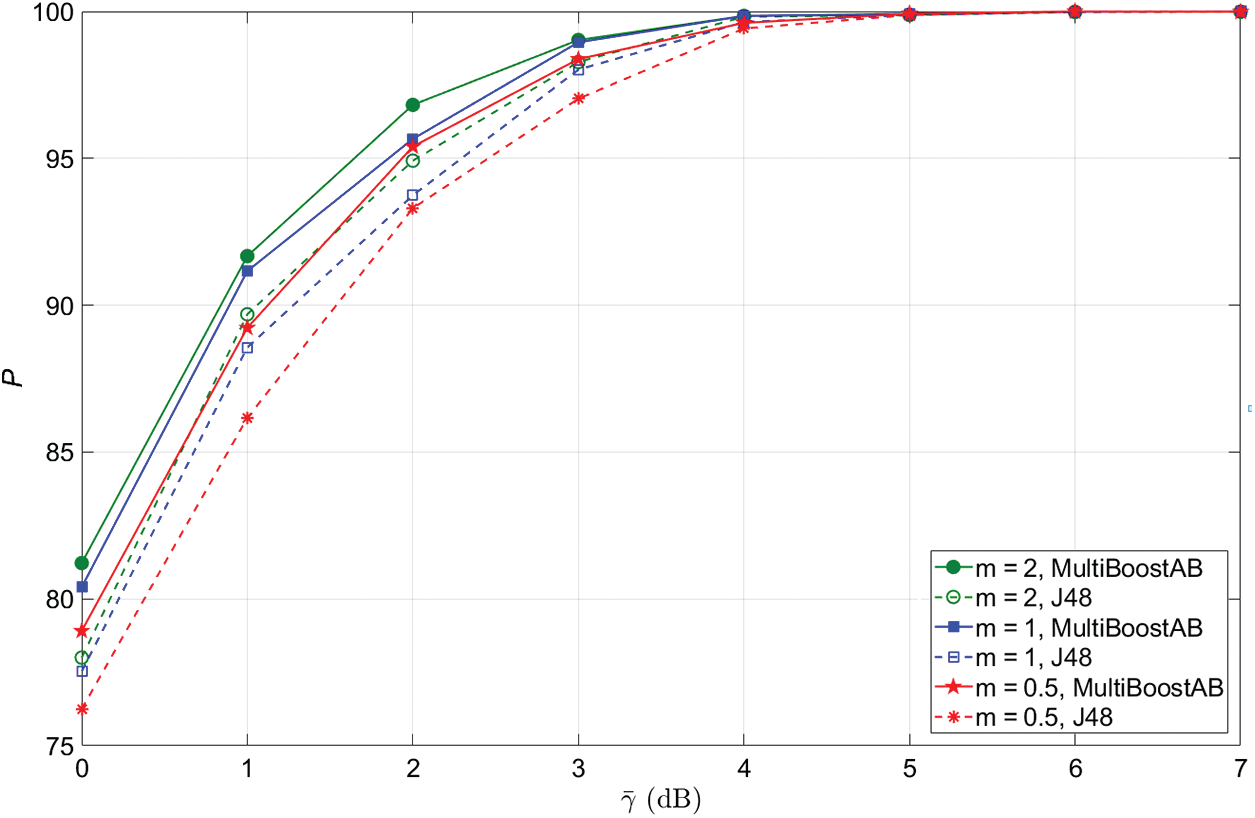
Figure 4: Impact of the Nakagami parameter,
4.3 Impact of the Symbols Number
Fig. 5 presents the average probability of correct classification,
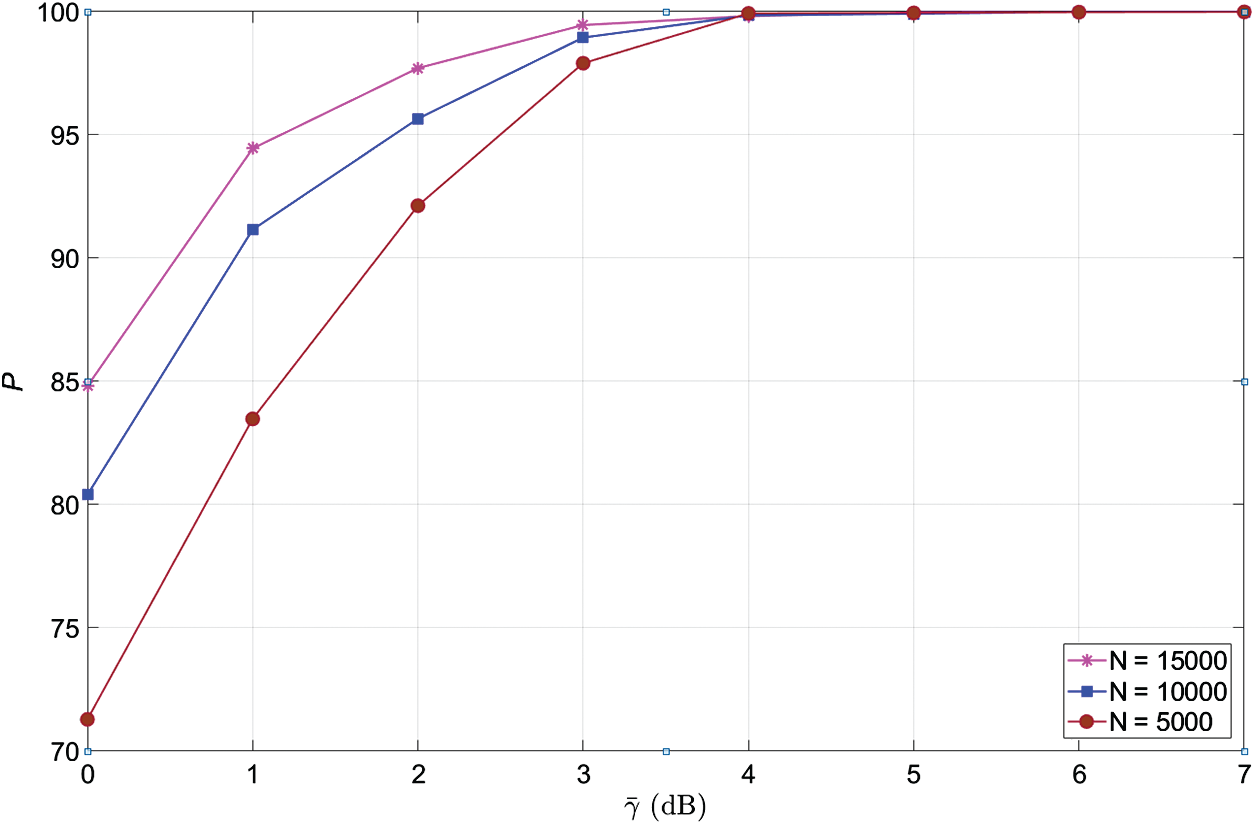
Figure 5: Impact of the symbols number,
4.4 Impact of the Relay Position
As seen in Eq. (6), we can incorporate different relay positions, where all distances involved in the calculation of the power gain are relative to the distance between the two users
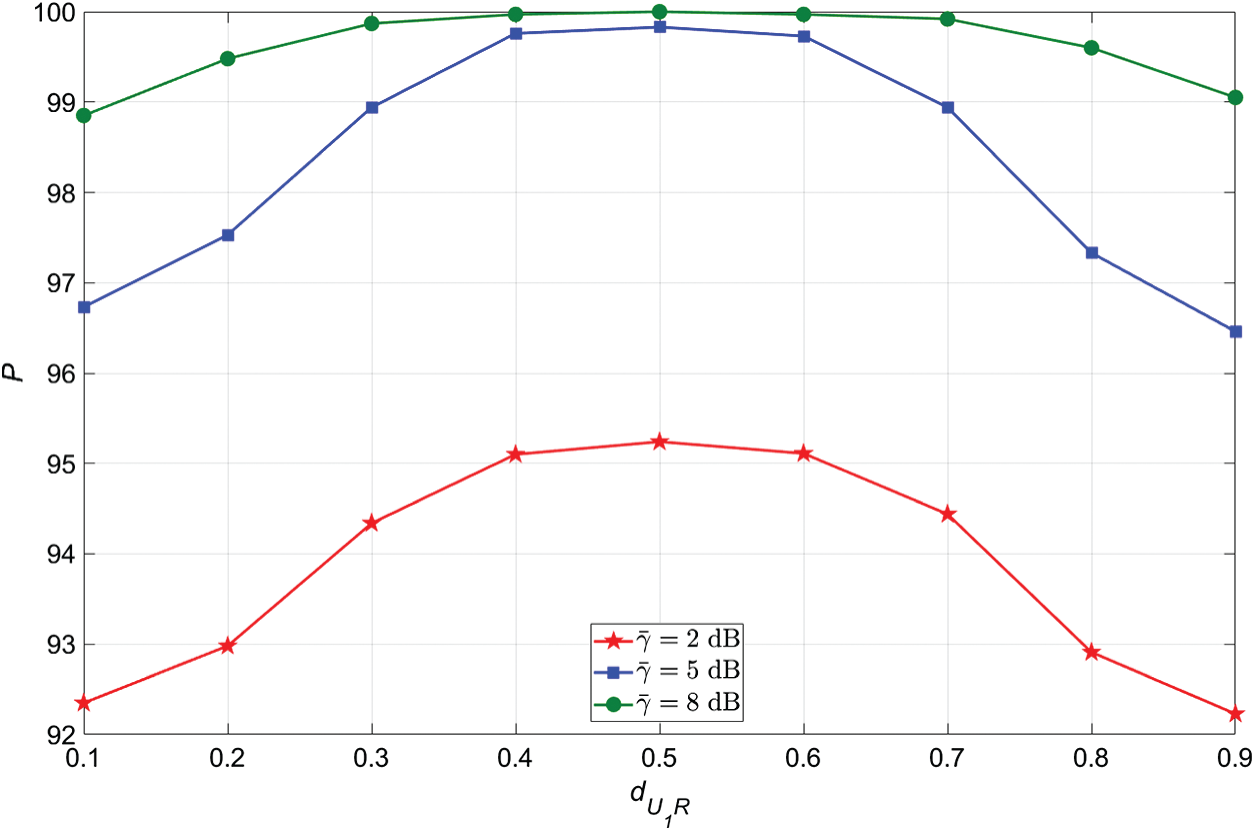
Figure 6: Impact of the distance between
Fig. 6 illustrates the average probability of correct classification of the proposed algorithm,
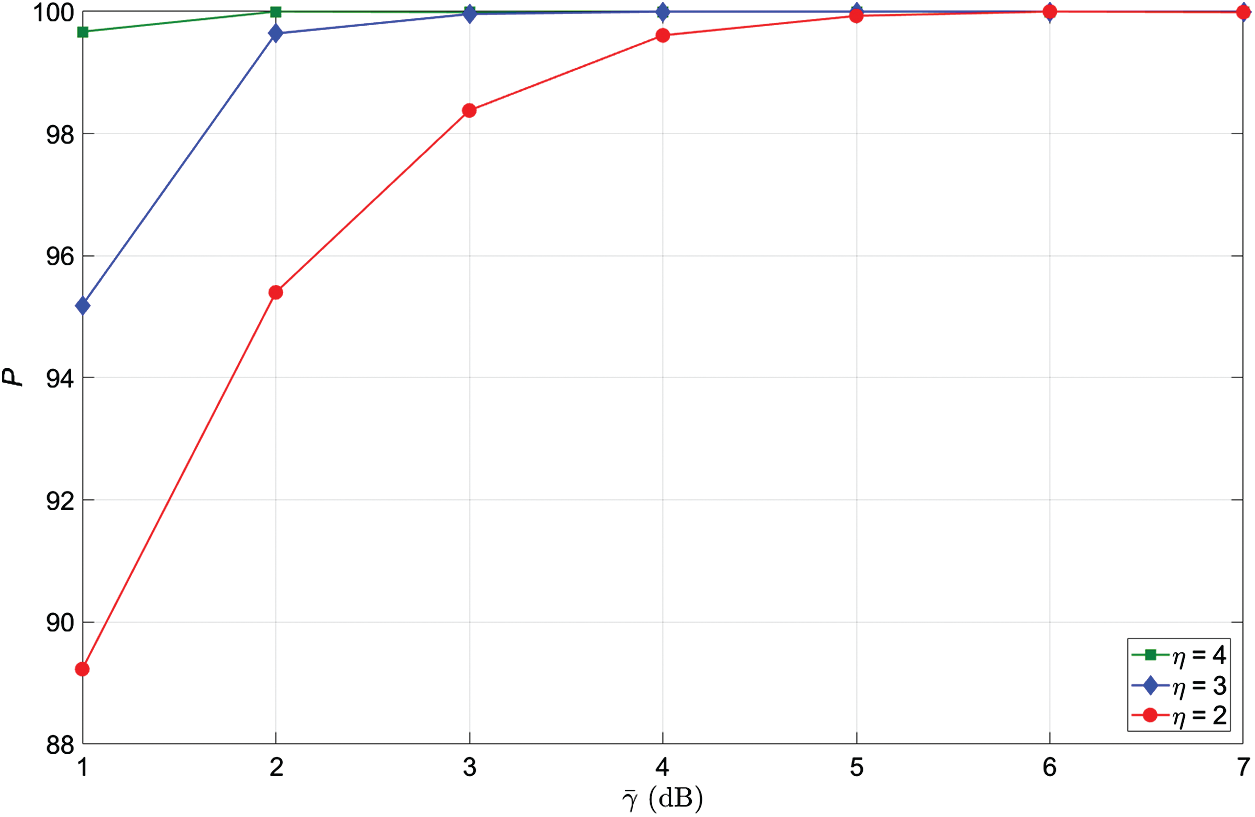
Figure 7: Impact of the path loss exponent,

Figure 8: Impact of the antennas number,
4.5 Impact of the Path Loss Exponent
Fig. 7 presents the average probability of correct classification of the proposed algorithm,
4.6 Impact of the Antenna Number
Fig. 8 shows the average probability of correct classification of the proposed algorithm,
We have proposed an automatic classification algorithm of superimposed modulations designed for MIMO TWCR network over Nakagami-
In the future work, we will investigate the use of deep learning based neural networks in order to further improve the probability of the correct classification of superimposed modulations at low SNR values.
Funding Statement: This work was supported by Jouf University.
Conflicts of Interest: The authors declare that they have no conflicts of interest to report regarding the present.
1. L. F. Xie, I. W.-H. Ho, Z. H. Situ, L. Lu and W. Lu, “Channel-coded physical-layer network coding with OFDM modulation,” IEEE Access, vol. 6, pp. 22267–22280, 2018. [Google Scholar]
2. Z. Xie, P. Chen, Z. Mei, S. Long, K. Cai et al., “Polar-coded physical layer network coding over two-way relay channels,” IEEE Communications Letters, vol. 23, no. 8, pp. 1301–1305, 2019. [Google Scholar]
3. T. Peng, Y. Wang, A. G. Burr and M. R. Shikh-Bahaei, “Physical layer network coding in network MIMO: A new design for 5G and beyond,” IEEE Transactions on Communications, vol. 67, no. 3, pp. 2024–2035, 2018. [Google Scholar]
4. F. Jamil, A. Javaid, T. Umer and M. H. Rehmani, “A comprehensive survey of network coding in vehicular ad-hoc networks,” Wireless Networks, vol. 23, no. 8, pp. 2395–2414, 2017. [Google Scholar]
5. L. F. Xie, I. W.-H. Ho, S. C. Liew, L. Lu and F. C. Lau, “The feasibility of mobile physical-layer network coding with BPSK modulation,” IEEE Transactions on Vehicular Technology, vol. 66, no. 5, pp. 3976–3990, 2016. [Google Scholar]
6. S. Chaoui, H. Ben Chikha and A. Masmoudi, “Network-coded SIR-based distributed coding scheme: A new soft estimate modelling and performance analysis,” AEU-International Journal of Electronics and Communications, vol. 70, no. 6, pp. 822–832, 2016. [Google Scholar]
7. S. Zhang, S. C. Liew and P. P. Lam, “Hot topic: Physical-layer network coding,” in Proc. 12th Annual ACM Int. Conf. on Mobile Computing and Networking, New York, NY, USA, pp. 358–365, 2006. [Google Scholar]
8. W. Nam, S.-Y. Chung and Y. H. Lee, “Capacity of the Gaussian two-way relay channel to within 1/2 bit,” IEEE Transactions on Information Theory, vol. 56, no. 11, pp. 5488–5494, 2010. [Google Scholar]
9. T. Huang, T. Yang, J. Yuan and I. Land, “Design of irregular repeat-accumulate coded physical-layer network coding for Gaussian two-way relay channels,” IEEE Transactions on Communications, vol. 61, no. 3, pp. 897–909, 2013. [Google Scholar]
10. H. Zhang and L. Cai, “Design of channel coded heterogeneous modulation physical layer network coding,” IEEE Transactions on Vehicular Technology, vol. 67, no. 3, pp. 2219–2230, 2017. [Google Scholar]
11. I. Parvez, A. Rahmati, I. Guvenc, A. I. Sarwat and H. Dai, “A survey on low latency towards 5G: RAN, core network and caching solutions,” IEEE Communications Surveys & Tutorials, vol. 20, no. 4, pp. 3098–3130, 2018. [Google Scholar]
12. H. Li, X.-W. Chang, Y. Cai and B. Champagne, “Efficient detection scheme for physical-layer network coding in multiway relay channels,” IEEE Access, vol. 7, pp. 167639–167652, 2019. [Google Scholar]
13. R. Y. Chang, S.-J. Lin and W.-H. Chung, “Symbol and bit mapping optimization for physical-layer network coding with pulse amplitude modulation,” IEEE Transactions on Wireless Communications, vol. 12, no. 8, pp. 3956–3967, 2013. [Google Scholar]
14. M. Noori and M. Ardakani, “On symbol mapping for binary physical-layer network coding with PSK modulation,” IEEE Transactions on Wireless Communications, vol. 11, no. 1, pp. 21–26, 2011. [Google Scholar]
15. P. Chen, L. Shi, S. C. Liew, Y. Fang and K. Cai, “Channel decoding for nonbinary physical-layer network coding in two-way relay systems,” IEEE Transactions on Vehicular Technology, vol. 68, no. 1, pp. 628–640, 2018. [Google Scholar]
16. X. Hu, Z. Chen and F. Yin, “Channel and delay estimation for asynchronous physical layer network coding,” AEU-International Journal of Electronics and Communications, vol. 87, no. 12, pp. 101–106, 2018. [Google Scholar]
17. X. Dang, Z. Huang, Q. Li and X. Yu, “Estimation of symbol timing in physical-layer network coding with arrival time differences,” IEEE Communications Letters, vol. 21, no. 2, pp. 330–333, 2016. [Google Scholar]
18. Q. Yang and S. C. Liew, “Asynchronous convolutional-coded physical layer network coding,” IEEE Transactions on Wireless Communications, vol. 14, no. 3, pp. 1380–1395, 2014. [Google Scholar]
19. Y. Huang, S. Wang, Q. Song, L. Guo and A. Jamalipour, “Synchronous physical-layer network coding: A feasibility study,” IEEE Transactions on Wireless Communications, vol. 12, no. 8, pp. 4048–4057, 2013. [Google Scholar]
20. L. Lu and S. C. Liew, “Asynchronous physical-layer network coding,” IEEE Transactions on Wireless Communications, vol. 11, no. 2, pp. 819–831, 2011. [Google Scholar]
21. Q. Nadeem, A. Kammoun and M. S. Alouini, “Elevation beamforming with full dimension MIMO architectures in 5G systems: A tutorial,” IEEE Communications Surveys & Tutorials, vol. 21, no. 4, pp. 3238–3273, 2019. [Google Scholar]
22. M. Turan, M. Öner and H. A. Çırpan, “Joint modulation classification and antenna number detection for MIMO systems,” IEEE Communications Letters, vol. 20, no. 1, pp. 193–196, 2015. [Google Scholar]
23. M. Mohammadkarimi, E. Karami and O. A. Dobre, “A novel algorithm for blind detection of the number of transmit antenna,” in Proc. Conf. on Cognitive Radio Oriented Wireless Networks, Doha, Qatar, pp. 441–450, 2015. [Google Scholar]
24. M. R. Oularbi, S. Gazor, A. Aissa-El-Bey and S. Houcke, “Enumeration of base station antennas in a cognitive receiver by exploiting pilot patterns,” IEEE Communications Letters, vol. 17, no. 1, pp. 8–11, 2012. [Google Scholar]
25. M. Marey, O. A. Dobre and B. Liao, “Classification of STBC systems over frequency-selective channels,” IEEE Transactions on Vehicular Technology, vol. 64, no. 5, pp. 2159–2164, 2014. [Google Scholar]
26. E. Karami and O. A. Dobre, “Identification of SM-OFDM and AL-OFDM signals based on their second-order cyclostationarity,” IEEE Transactions on Vehicular Technology, vol. 64, no. 3, pp. 942–953, 2014. [Google Scholar]
27. K. Liu, J. P. C. CDa Costa, H. C. So and A. L. De Almeida, “Semi-blind receivers for joint symbol and channel estimation in space-time-frequency MIMO-OFDM systems,” IEEE Transactions on Signal Processing, vol. 61, no. 21, pp. 5444–5457, 2013. [Google Scholar]
28. S. Cai, T. Matsumoto and K. Yang, “SIMO channel estimation using space-time signal subspace projection and soft information,” IEEE Transactions on Signal Processing, vol. 60, no. 8, pp. 4219–4235, 2012. [Google Scholar]
29. H. Ben Chikha, A. Almadhor and W. Khalid, “Machine learning for 5G MIMO modulation detection,” Sensors, vol. 21, no. 5, pp. 1556, 2021. [Google Scholar]
30. S. Zheng, P. Qi, S. Chen and X. Yang, “Fusion methods for CNN-based automatic modulation classification,” IEEE Access, vol. 7, pp. 66496–66504, 2019. [Google Scholar]
31. W. Ben Chikha and R. Attia, “On the utility of MIMO multi-relay networks for modulation identification over spatially-correlated channels,” Telecommunication Systems, vol. 64, no. 4, pp. 735–747, 2017. [Google Scholar]
32. F. Wang and X. Wang, “Fast and robust modulation classification via Kolmogorov–Smirnov test,” IEEE Transactions on Communications, vol. 58, no. 8, pp. 2324–2332, 2010. [Google Scholar]
33. J. Zhang, D. Cabric, F. Wang and Z. Zhong, “Cooperative modulation classification for multipath fading channels via expectation-maximization,” IEEE Transactions on Wireless Communications, vol. 16, no. 10, pp. 6698–6711, 2017. [Google Scholar]
34. F. Wang, O. A. Dobre, C. Chan and J. Zhang, “Fold-based Kolmogorov–Smirnov modulation classifier,” IEEE Signal Processing Letters, vol. 23, no. 7, pp. 1003–1007, 2016. [Google Scholar]
35. W. Ben Chikha, S. Chaoui and R. Attia, “Performance of Adaboost classifier in recognition of superposed modulations for MIMO TWRC with physical-layer network coding,” in Proc. 25th Int. Conf. on Software, Telecommunications and Computer Networks, Split, Croatia, IEEE, pp. 1–5, 2017. [Google Scholar]
36. W. Ben Chikha, S. Chaoui and R. Attia, “Identification of superposed modulations for two-way relaying MIMO systems with physical-layer network coding,” IET Communications, vol. 11, no. 2, pp. 225–231, 2017. [Google Scholar]
37. B. Zhang, Z. He, K. Niu and L. Zhang, “Robust linear beamforming for MIMO relay broadcast channel with limited feedback,” IEEE Signal Processing Letters, vol. 17, no. 2, pp. 209–212, 2009. [Google Scholar]
38. H. Ochiai, P. Mitran and V. Tarokh, “Design and analysis of collaborative diversity protocols for wireless sensor networks,” in Proc. 60th IEEE Vehicular Technology Conf., Los Angeles, CA, USA, vol. 7, pp. 4645–4649, 2004. [Google Scholar]
39. H. Ben Chikha, “Performance of Adaboost in modulation recognition for spatially-correlated cooperative MIMO systems,” in Proc. IEEE Wireless Communications and Networking Conf., Barcelona, Spain, pp. 1–6, 2018. [Google Scholar]
40. O. A. Dobre, A. Abdi, Y. Bar-Ness and W. Su, “Survey of automatic modulation classification techniques: Classical approaches and new trends,” IET Communications, vol. 1, no. 2, pp. 137–156, 2007. [Google Scholar]
41. P. McCullagh, Tensor Methods in Statistics. London, UK: Chapman Hall, 1987. [Google Scholar]
42. C. M. Spooner, “On the utility of sixth-order cyclic cumulants for RF signal classification,” in Proc. Conf. Record of Thirty-Fifth Asilomar Conf. on Signals, Systems and Computers, Pacific Grove, CA, USA, vol. 1, pp. 890–897, 2001. [Google Scholar]
43. G. I. Webb, “Multiboosting: A technique for combining boosting and wagging,” Machine Learning, vol. 40, no. 2, pp. 159–196, 2000. [Google Scholar]
44. L. Rokach and O. Maimon, “Decision trees,” in Data Mining and Knowledge Discovery Handbook. Boston, MA: Springer, pp. 165–192, 2005. [Google Scholar]
45. W. Ben Chikha, I. Dayoub, W. Hamouda and R. Attia, “Modulation recognition for MIMO relaying broadcast channels with direct link,” IEEE Wireless Communications Letters, vol. 3, no. 1, pp. 50–53, 2014. [Google Scholar]
46. M. Hall, E. Frank, G. Holmes, B. Pfahringer, P. Reutemann et al., “The WEKA data mining software: An update,” ACM SIGKDD Explorations Newsletter, vol. 11, no. 1, pp. 10–18, 2009. [Google Scholar]
47. P. Refaeilzadeh, L. Tang and H. Liu, “Cross-validation,” Encyclopedia of Database Systems, vol. 5, pp. 532–538, 2009. [Google Scholar]
 | This work is licensed under a Creative Commons Attribution 4.0 International License, which permits unrestricted use, distribution, and reproduction in any medium, provided the original work is properly cited. |